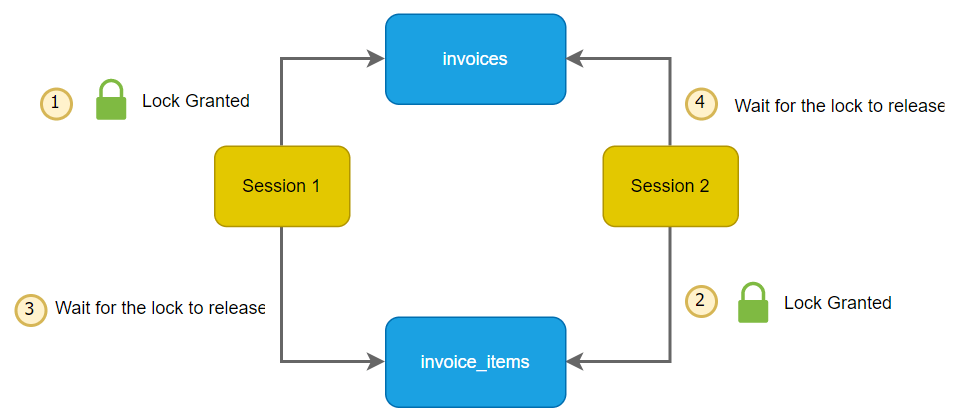Summary: in this tutorial, you’ll learn about the SQL Server deadlock and how to simulate a deadlock.
Introduction to the SQL Server deadlock
A deadlock is a concurrency problem in which two sessions block the progress of each other. The first session has a lock on a resource that the other session wants to access, and vice versa.
The following picture illustrates a deadlock in SQL Server:

In this picture, the invoices and invoice_items are tables.
- First, session one accesses the
invoicestable and locks it. - Second, session two locks the
invoice_itemstable and locks it. - Third, session one wants to access the
invoice_itemstable but needs to wait for session two complete. At the same time, session two wants to access theinvoicestable but needs to wait for session two to complete.
As the result, two sessions are waiting for each other until SQL Server proactively terminates one of them. The session that is terminated by SQL Server is called a deadlock victim.
SQL Server deadlock example
Let’s take a look at an example of creating a deadlock. In this example, we’ll first create the invoices and invoice_items tables:
CREATE TABLE invoices (
id int IDENTITY PRIMARY KEY,
customer_id int NOT NULL,
total decimal(10, 2) NOT NULL DEFAULT 0 CHECK (total >= 0)
);
CREATE TABLE invoice_items (
id int,
invoice_id int NOT NULL,
item_name varchar(100) NOT NULL,
amount decimal(10, 2) NOT NULL CHECK (amount >= 0),
tax decimal(4, 2) NOT NULL CHECK (tax >= 0),
PRIMARY KEY (id, invoice_id),
FOREIGN KEY (invoice_id) REFERENCES invoices (id)
ON UPDATE CASCADE
ON DELETE CASCADE
);
INSERT INTO invoices (customer_id, total)
VALUES (100, 0);
INSERT INTO invoice_items (id, invoice_id, item_name, amount, tax)
VALUES (10, 1, 'Keyboard', 70, 0.08),
(20, 1, 'Mouse', 50, 0.08);
UPDATE invoices
SET total = (SELECT
SUM(amount * (1 + tax))
FROM invoice_items
WHERE invoice_id = 1
);Code language: SQL (Structured Query Language) (sql)Then, we’ll create two sessions to connect to the database. Here’s the sequence of statements that you need to execute from each session.
| Session 1 | Session 2 |
|---|---|
| BEGIN TRAN; | |
| BEGIN TRAN; | |
| UPDATE invoices SET customer_id = 100 WHERE id = 1; | |
| UPDATE invoice_items SET amount = 100 WHERE id = 10; | |
| UPDATE invoice_items SET item_name = ‘Cool Keyboard’ WHERE id = 10; | |
| Blocked | UPDATE invoices SET total = (SELECT SUM(amount * (1 + tax)) FROM invoice_items WHERE invoice_id = 1) WHERE id = 1; |
| Blocked |
Once a deadlock occurs, SQL Server will kill a deadlock victim. In our case, the deadlock victim is the process ID 65.
Transaction (Process ID 65) was deadlocked on lock resources with another process and has been chosen as the deadlock victim. Rerun the transaction.Code language: SQL (Structured Query Language) (sql)Summary
- SQL Server deadlock is a problem in which two sessions lock on a resource that the other session wants to access and vice versa.